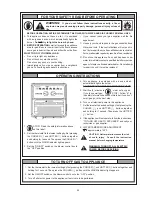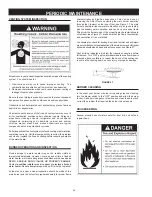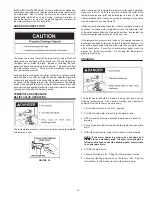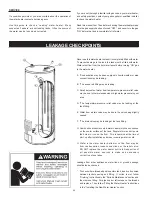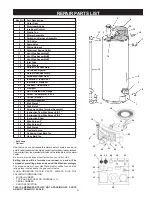
17
PLANNING THE VENT SYSTEM
Plan the route of the vent system from the discharge of the blower
to the planned location of the vent terminal.
1. Layout total vent system to use a minimum of vent pipe and elbows.
2. This water heater is capable of venting flue gases equivalent to
25' (7.6 m) of 2" pipe, 65' (19.8 m) of 3" pipe, or 128' (39.0 m) of
4" pipe as listed in Table 1.
TABLE 1
Number of
2" Maximum
3" Maximum
4" Maximum
90° Elbows
Pipe - ft. (m)
Pipe - ft. (m)
Pipe - ft. (m)
1
20 (6.1)
60 (18.3)
120 (36.6)
2
15 (4.6)
55 (16.8)
112 (34.1)
3
10 (3.0)
50 (15.2)
104 (31.7)
4
--
45 (13.7)
96 (29.3)
5
--
40 (12.2)
88 (26.8)
6
--
35 (10.7)
80 (24.3)
The minimum vent lengths for each of the pipe sizes is one 90° on
top of the unit plus 2' (61 cm) of straight pipe and the appropriate
termination.
NOTE:
The equivalent feet (m) of pipe listed above are exclusive
of the termination. That is, the termination, with an installed
screen, is assumed to be in the system and the remainder of the
system must not exceed the lengths discussed above.
3. The blower discharge adapter is made to accept only straight
sections of 2" pipe. To start, a minimum of 2 inches (5.1 cm) of
2" pipe must be attached to the blower discharge, see Figure 17.
If using 2" inch vent pipe:
A minimum of 2 inches (5.1 cm) must be attached to the blower
before the first elbow. After the first elbow add the additional
venting required for the installation. The total system cannot
exceed the lengths discussed above, where each elbow is
equal to 5 feet (1.5 m) of straight pipe.
If using 3" or 4" inch vent pipe:
Two inches (5.1 cm) of pipe must be attached to the blower discharge
before adding a reducer to acquire the desired pipe diameter. An
appropriately sized 45 degree elbow (supplied locally-a schedule 40
DWV) vent terminal must be obtained with an equivalent screen
(supplied in vent kit). The total system cannot exceed the equivalent
pipe lengths discussed above where each elbow is equal to 5 feet
(1.5 m) of straight pipe (3" vent pipe) or 8 feet (2.4 m) of straight pipe
(4" vent pipe).
NOTE:
This unit can be vented with PVC pipe materials (Cellular
Core ASTM-F891; DWV ASTM-D2665 or CSA B181.2; Schedule
40, 80, 120 ASTM-D1785 or CSA B137.3; or SDR Series ASTM-
D2241 or CSA B137.3), CPVC pipe materials (CPVC41 ASTM-
D2846 or CSA B137.6; Schedule 40, 80 ASTM-F441 or CSA
B137.6; or SDR Series ASTM-F442), ABS pipe materials
(Schedule 40 DWV ASTM-D2661 or CSA B181.1 or Schedule
40 DWV Cellular Core ASTM-F628). The fittings, other than the
TERMINATION should be equivalent to PVC-DWV fittings
meeting ASTM D-2665 (Use CPVC fittings, ASTM F-438 for CPVC
pipe and ABS fittings, ASTM D-2661/3311 for ABS pipe). If CPVC
or ABS pipe and fittings are used, then the proper cement must
be used for all joints, including joining the pipe to the Termination
(PVC Material). If local codes do not allow the use of the PVC
termination when a material other than PVC is used for venting,
then an equivalent fitting of that material may be substituted if
the screen in the PVC terminal is removed and inserted into the
new fitting.
PVC Materials should use ASTM D-2564 Grade Cement; CPVC
Materials should use ASTM F-493 Grade Cement and ABS
Materials should use ASTM D-2235 Grade Cement.
If the water heater is being installed as a replacement for an existing
power vented heater in pre-existing venting, a thorough inspection
of the existing venting system must be performed prior to any
installation work. Verify that the correct material as detailed above
has been used, and that the minimum or maximum vent lengths
and terminal location as detailed in this manual have been met.
Carefully inspect the entire venting system for any signs of cracks
or fractures, particularly at the joints between elbows and other
fittings and the straight runs of vent pipe. Check the system for
signs of sagging or other stresses in the joints as a result of
misalignment of any components in the system. If any of these
conditions are found, they must be corrected in accordance with
the venting instructions in this manual before completing the
installation and putting the water heater into service.
NOTE:
A.
For water heaters in locations with high ambient
temperatures (above 100°F) it is recommended that CPVC or
ABS pipe and fittings be used.
B.
A 22.5 degree elbow (2" vent
pipe) or a 45 degree elbow (3" and 4" vent pipe) with an installed
screen VENT TERMINAL must be used in all cases.
4. There will be some installations where condensate will be formed
in the horizontal runs of the vent system. This condensate will
run into the condensate boot attached to the blower and out the
fitting. The water heater is shipped with condensate hose that
attaches to the fitting on the condensate boot. No other Tee or
fitting is required. See Figures 17, 20 and 21.
CONDENSATE
This water heater is a condensing unit and requires a drain to be
located in close proximity to allow the condensate to drain safely. The
condensate drains from the unit at the exhaust tee located at the
bottom of the unit (see figure 16) and from two places on the blower
assembly (see figure 17). Condensate from this water heater is mildly
acidic. Please note that some local codes require that condensate is
treated by using a pH neutralizing filter prior to disposal.
NOTE: It is important that the condensate hose on the bottom of the
unit is not installed elevated above the clamp that is secured to the side
of the jacket, see figure 16. This must be true for the entire length of the
hose from the clamp to the exit into an appropriate drain. If these
instructions are not followed or if the condensate hose is blocked, water
will spill from the condensate trap. As with every water heater installation,
a drain pan should be used to prevent water damage to the surrounding
area. If necessary, a condensate pump with an incorporated reservoir
may be used to pump the water to an appropriate drain. To avoid
condensate spillage, select a pump with an overflow switch.
Caution must be used to ensure that the drain is free and clear of
debris and will not allow backflow through the condensate hose.
Consideration must be given to avoid freezing of the condensate lines
which could result in excessive build up of condensate inside the water
heater. Waterproof heat tape may be required to prevent freezing of the
condensate lines. Please ensure that the outlet of the condensate drain
does not create a slippery condition which could lead to personal injury.























